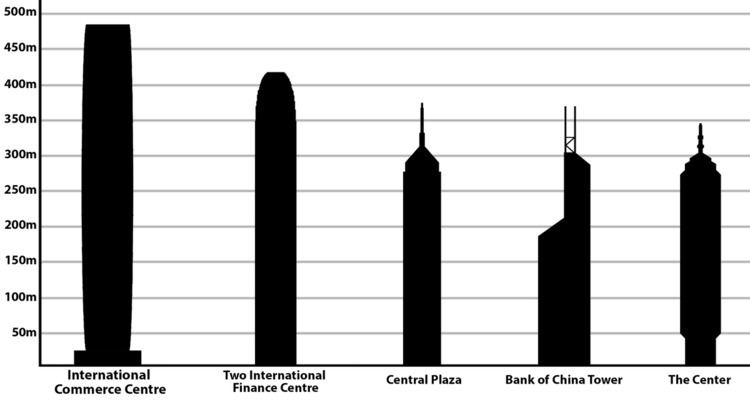 | ||
The Hong Kong Special Administrative Region (SAR) of China has at least 7,840 high-rise buildings, with no fewer than 1,303 skyscrapers standing taller than 100 m (328 ft) and at least 316 buildings over 150 m (492 ft) in height. The tallest of these skyscrapers is the 108-storey International Commerce Centre, completed in 2010, which stands 484 m (1,588 ft) and is the ninth tallest building in the world. The total built-up height (combined heights) of these skyscrapers is approximately 333.8 km (207 mi), making Hong Kong the world's tallest urban agglomeration. Furthermore, reflective of the SAR's high population densities, Hong Kong has more people living at the 15th floor or higher, and more buildings of at least 100 m (328 ft) and 150 m (492 ft) height than any other place in the world.
Contents
- History
- Notable buildings
- Tallest buildings
- Tallest buildings under construction or planned
- Timeline of tallest buildings
- Notable abandoned cancelled and vision projects
- Demolished buildings
- References
Most of Hong Kong's high-rise buildings are concentrated along Hong Kong Island's northern shore, Kowloon, New Kowloon, and in the New Towns (satellite towns) of the New Territories, such as Tuen Mun or Sha Tin. Additional high-rises are located on Ap Lei Chau, along Hong Kong Island's southern shoreline and areas in proximity to stations of the Mass Transit Railway (MTR).
The skyline of Hong Kong is considered amongst the best in the world, with the surrounding mountains and Victoria Harbour complementing the skyscrapers. Each evening, at least 44 skyscrapers and buildings on both sides of Victoria Harbour light up in a synchronised show called A Symphony of Lights, named by the Guinness Book of World Records as the largest permanent light and sound festival in the world.
History
The first high-rise in Hong Kong was the third-generation building of the Hong Kong & Shanghai Bank, completed in 1935. The building stood 70 m (230 ft) tall with 13 floors and existed for five decades before being demolished for the construction of the HSBC Main Building. High-rise construction was limited in the early part of the 20th century. However, beginning in the 1970s, Hong Kong experienced a general trend of high-rise building construction that has continued to the present. This trend is in large part a result of the city's rugged, mountainous terrain and lack of flat land. The city entered a construction boom in 1980, which lasted roughly until 1993. Among the buildings built during these years are Hopewell Centre (1980), Bank of China Tower (1990), and Central Plaza (1992), three of the territory's tallest buildings upon their respective dates of completion.
Beginning in 1998, Hong Kong entered a second, much larger building boom that lasted until the early 2010s. The second boom saw the inauguration of the International Commerce Centre, the SAR's first, and only building to date with more than 100 floors, Two International Finance Centre, Nina Tower I, and One Island East. At the height of the construction boom, in the years 2003 and 2005 alone, the SAR witnessed the completion of 56 and 28 skyscrapers over 150 m (490 ft) in height, respectively. The proliferation of multi-tower, high-rise building complexes, such as public housing estates and transit-oriented developments at or near MTR stations (known as rail + property development), greatly increased the number of skyscrapers in the SAR.
Unlike previous building trends of the 1980s and early 1990s, many high-rise buildings of the second boom are for residential use due to a surge in demand for luxury housing properties in Hong Kong. In addition, the closure of the Kai Tak Airport and relaxation of height restrictions on the Kowloon Peninsula allowed many tall skyscrapers to rise in Kowloon, such as Sorrento, Langham Place Office Tower, and The Cullinan, all of which exceed 200 m (656 ft) in height. Skyscrapers also grew in the New Territories, such as the developments of Metro Town and LOHAS Park in Tseung Kwan O. However, as a result of heightened community awareness of the skyscrapers' effect on air circulation (wall effect), air pollution and the urban heat island, opposition to tall and broad buildings (skyscraper walls) arose during the latter part of this building boom.
As of October 2015, there are a total of 146 high-rise buildings under construction or planned in Hong Kong.
Notable buildings
Tallest buildings
This lists ranks Hong Kong skyscrapers that stand at least 180 m (591 ft) tall, based on standard height measurement. This includes spires and architectural details but does not include antenna masts. The "Year" column indicates the year in which a building was completed.
* Indicates still under construction, but has been topped out.
Tallest buildings under construction or planned
This list ranks under construction, topped out and planned buildings that are expected to stand at least 180 metres (591 ft) tall, based on standard height measurement. This includes spires and architectural details but does not include antenna masts. The "Year" column indicates the year in which a building is expected to be complete. A floor count of 50 stories is used as the cutoff in place of a height of 180 m (591 ft) for buildings whose heights have not yet been released by their developers.
*Table entry without text indicate that one or more of the following information regarding building heights, floor counts and/or year of completion has not yet been released.
Timeline of tallest buildings
This lists buildings that once held the title of tallest building in Hong Kong.
Notable abandoned, cancelled and vision projects
This lists notable projects that were abandoned, cancelled or never meant to be built that had a planned height of at least 400 m (1,300 ft).
* Table entries without text indicate that information regarding floor counts have not been determined or remain unknown.
Demolished buildings
The following are buildings that were demolished which once stood at least 40 m (131 ft) tall.
